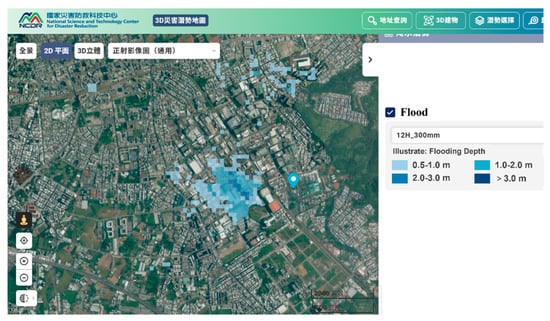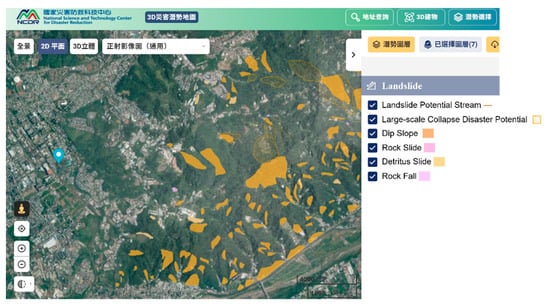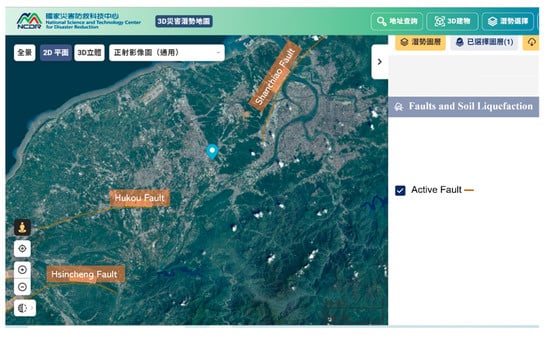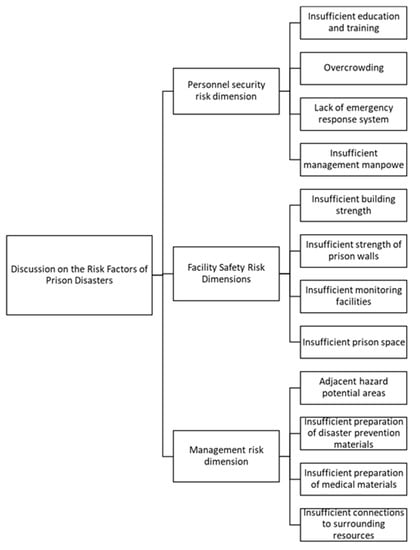Abstract
Prisons have always been considered self-sufficient, and government disaster response plans at all levels rarely mention prisons. Prisons may face emergencies such as earthquakes, floods, fires, prison escapes, or riots. Prisons are located in various disaster potential areas. If prepared, the safety of prison inmates can be secured. If it is not handled properly, society can be threatened. Through a literature review, TELES and SESS earthquake loss estimation system, and other methods, we sorted out three disaster risk factors, personnel risk, equipment risk, and management risk. In the safety part of facilities, old buildings, old prison walls, insufficient monitoring facilities, and insufficient prison space need to be included. The management aspect includes the potential of adjacent disasters. Insufficient regional and disaster prevention materials, medical materials, and connections with surrounding resources need to be solved.
1. Introduction
In recent decades, the global prison population has increased significantly. At present, it has exceeded 11 million. More than 60% of the national correction systems in the world are overcrowded. Due to the sharp increase in the number of inmates, they do not receive enough corresponding resources, resulting in overcrowding and an unhealthy environment in correction institutions, which affects the physical and mental health of staff and detainees (Heard, 2019) [1]. At the same time, it also creates a hotbed of infectious diseases. Overcrowding in correctional institutions has always been a problem faced by countries all over the world. Fifty-one correctional institutions affiliated with the correctional department of the Ministry of Justice accommodate more than 54,000 people (the agency of corrections, 2022) [2]. Taking Taipei Prison as an example, the number of inmates is 3955, of which 3401 are approved, 554 are overcharged, and the overcharge rate is 16.3%. There is the Shanchiao fault and Hukou fault nearby the prisons. When an earthquake occurs, it causes a large number of casualties without disaster management.
Prisons have always been regarded as self-sufficient. The disaster response plans of governments at all levels rarely mention prisons. They are often ignored or forgotten in the whole disaster relief process because prisons are not included in the list of disaster work items of the county and municipal governments. If prisons do not have proper disaster response and post-disaster measures, great damage may occur. According to the statistics of the COVID prison project in the United States, 486,585 people were diagnosed with COVID-19 since 14 January 2022. A total of 156,500 prison staff were diagnosed, and 259 died (the COVID prison project, 2022) [3].
Prisons may also face emergencies such as earthquakes, floods, fires, and prison escapes. Prisons are located in various potential areas of disasters. If they are prepared, they can ensure the safety of prison inmates. If they are not, the disaster of prisons threatens society. Adenrele Awotona summarizes the main reasons for ineffective disaster relief in past prison disaster cases in the United States as follows: lack of communication among departments, the staff’s inexperience in education, training, and drilling of disaster relief, no supporting contingency plan or unclear plan content and wrong decision-making, improper resettling of sexual offenders, and inappropriate management of prison inmates in disasters [4].
2. Literature Review
The Taiwan Correctional Service was established in 2011 with a long-term shortage of manpower and funds. There is no sufficient manpower in correctional institutions. Therefore, the operation of the institutions is less efficient and even affects the morale of the staff. It has become normal for institutions to have a serious imbalance in the proportion of manpower and workload. The heavy burden and the shortage of manpower make correction work difficult. Therefore, Taiwan’s correction institutions are focusing on warehouse management. For maintaining the basic operation of the institutions, the staff is exhausted, which prohibits the personalized treatment of the detainees. During day and night, the supervisor on duty has to face hundreds of inmates alone. The supervisor can only take care of the inmates in special conditions. The overall atmosphere is negative. This attitude undoubtedly affects correction work.
Taipei Prison is located in Guishan District, Taoyuan City. It was established in 1963. In 2017, the Zhishan Building was officially opened as the first high-rise prison in Taiwan. A total of 146 rooms have the capacity to house 1300 people for the Northern Prison (Freedom Times, 2017) [5]. Although there is a new building, each inmate is only allowed to have less than 0.211 m2. Currently, the number of inmates in Taipei Prison is 3955, of which the approved capacity of inmates is 3401, and the number of overcharged is 554. The overcharge rate is 16.3%. Prisoners between the ages of 40–50 account for 29% (1147), followed by those between the ages of 30–40 (946, 23.9%). A total of 857 are between the ages of 20–30, accounting for 21.7%. A total of 364 are over 60 years old, accounting for 9.2%. The care of the elderly becomes a new problem in future prisons.
We use the FEMA disaster analysis table for fires, landslides, floods, and earthquakes. The analysis result shows that earthquakes are most likely to be large-scale disasters, and fire is low. As shown in Table 1, floods and landslides have obvious cycles, and prevention work can be prepared in advance. The impact time is short, and the impact of serial consequences is not significant. Using the flooding simulation of the National Disaster Prevention and Rescue Technology Center, as shown in Figure 1, the potential flooding area with 300 mm in 12 h is not located near the Taipei Prison. The landslide simulation shows that none of the Taipei prisons are affected (Figure 2).

Table 1.
Disaster-causing natural disasters on the Taipei Prison.

Figure 1.
12 h 300 mm potential inundation map of the Taipei Prison.

Figure 2.
Landslide potential map of the Taipei Prison.
Fires and earthquakes are least likely to occur, but their potential impact is the most serious (Table 1). Although the earthquake can be detected in advance, the onset time is short. Thus, it may be too late to give an early warning. After the earthquake, the cascade consequences are the most serious, including aftershocks, slope collapse, and fire. The location map of the active faults of the National Disaster Prevention and Rescue Science and Technology Center shows that the Hukou fault passes through Taoyuan City without damage. Although the Shanchaio fault does not pass through Taoyuan City (Figure 3), the location is close to where the Taipei Prison is located.

Figure 3.
Faults potential map of the Taipei Prison.
We use the Simple Earthquake Seismic System (SESS), a simple earthquake disaster loss estimation system developed by the Fire Department of the Ministry of the Interior. The system mainly uses the Japanese earthquake experience to compare various elements such as the earthquake occurrence time and related situations. It is easy to complete the disaster simulation in a short time, as the seismic value is the maximum surface acceleration (PGA). When an earthquake occurs, the earthquake information (epicenter and scale) can be obtained from the Bureau of Meteorology. After inputting the point source, the earthquake value (PGA) of each region is obtained. The system estimates the collapse of buildings related to residents’ lives and properties, the number of casualties, fires after the earthquake, sheltering and evacuation of people, and other four basic disasters. In terms of calculation, it takes about 1 to 2 min speed to estimate the damage to a county or city. The Taiwan Earthquake Loss Estimation System (hereinafter referred to as TELES) developed by the National Earthquake Center to simulate loss is also used to evaluate the potential danger of earthquakes and disasters and is used for government disaster relief and risk assessment and management. We simulate the fault zones around the selected cases to confirm the damage to the houses around the prison and estimate the casualties around the prison [6].
According to the simulation results of TELES and SESS, the disaster damage in Taoyuan City is shown in Table 2. The Hukou fault passes through Taoyuan city and belongs to the second type of active fault. It was active 100,000 to 10,000 years ago. Although it belongs to the second type of active fault, the probability of its occurrence is not lower than that of the first type of active fault. (Active in the past 10,000 years) it means that it is still active. Therefore, once the Hukou fault is dislocated, according to the TELES simulation in Table 2, the number of buildings collapsed in Taoyuan City is as high as 14,134, which is the highest among the four faults. In the SESS simulation, the Hukou fault may cause 798 collapses of buildings in Taoyuan City. Although the Shanchiao fault does not pass through Taoyuan City, it is close to Taoyuan near the Guishan District where Taipei Prison is located. According to the TELES simulation in Table 2, the number of buildings that collapse in Taoyuan City reaches 12,495, ranking second among the four faults. In the SESS simulation of the Shanchiao fault, the number of collapsed buildings in Taoyuan City was 1229, which is the highest of the four faults. The Hsinchu fault and Xincheng fault do not pass through Taoyuan City, but it is not near Taoyuan. Therefore, these two faults have little impact on Taoyuan City, and the number of collapsed buildings is zero.

Table 2.
Simulation results of earthquake casualties in Taoyuan City event.
3. Establishment of Prison Disaster Risk Factors
Purdum et al. discussed the impact of disasters on inmates and the prison destruction to surrounding communities [7]. He believed that the impact of disasters and the costs of disaster reduction, preparation, response, and recovery from these events are rising. Inmates in prisons are a source of low-cost labor for various tasks before, during, and after the disaster. However, states plan to use inmate labor to meet emergency management, increase urban resilience, and reduce labor costs [8]. Loic et al. discussed the views of New Zealand prisons on disaster risk reduction and emergency management. They explored prison exposure and identified the vulnerability and capacity of detainees and documented the policies and practices of disaster risk reduction and emergency management. It showed that raising awareness at the national level and improving disaster risk reduction policies and emergency management initiatives were not sufficient enough to address the increased risks and the special vulnerability of the rapid growth of inmates. The inherent abilities of these inmates have not been developed. They further highlighted the serious lack of communication in the implementation interface of prison management, disaster reduction, and emergency management in New Zealand [9]. Others proposed the fate of prisons and detainees in disasters in 2012, which attracted very limited attention from scholars and policymakers. However, both prisons and detainees are particularly affected by catastrophic events related to external natural and other disasters. This study focused on three aspects to explore the relationship between imprisonment, marginalization, and vulnerability to natural disasters and other factors: (1) a spatial form of marginalization, through the geography, potential danger, location and secluded nature of the prison, as well as helping to face the danger, (2) a form of social marginalization that deprives inmates who are already poor of further access to economic opportunities, medical resources, and interpersonal relationships, which have proved to be key drivers of people’s vulnerability, and (3) a form of political marginalization, including the limited resources provided by the state and its institutions which leads to poor facilities, possible vulnerability and overcrowding, and the lack of visibility of prisons in government policies [10]. Smog is the main cause of toxic substances in Western countries. Meroueh et al. found that there were many tragic fires in prisons. More than 380 inmates died in Honduras in 2012, and 136 inmates died in the Dominican Republic in 2005. Because of the particularity of prisons, fires easily cause a large number of deaths [11].
The purpose of this study is to explore the risk factors of prisons when facing disasters. Through secondary data collection, relevant paper references, and cases, the key factors affecting risk management are summarized. In addition, the earthquake loss estimation system, TELES, and SEES are used to analyze and simulate the number of total and half-collapsed buildings and casualties near a prison due to earthquake disasters. The possible risk factors are summarized and classified. First of all, the personnel structure includes insufficient education and training, an excessive number of detainees, a lack of response system or imperfect system, and insufficient management personnel. The facility safety includes old buildings, old prison exterior walls, insufficient monitoring facilities, and insufficient prison space. The management structure includes adjacent disaster potential areas, and insufficient preparation of disaster prevention materials. The medical materials are not well prepared and the contact with surrounding resources is not enough. The detailed structure is shown in Figure 4.

Figure 4.
Prison disaster risk factor structure.
4. Conclusions
Prison issues are rarely discussed, especially when prisons face the risk of disasters. We proposed three risks: personnel risk, facility risk, and management risk. The personnel structure includes insufficient education and training, an excessive number of detainees, a lack of response system or imperfect system, and insufficient management personnel. The facility safety includes old buildings, old prison exterior walls, monitoring facilities, and insufficient prison space. The management structure includes the adjacent disaster potential area, the insufficient preparation of disaster prevention materials, the insufficient preparation of medical materials, and the insufficient connection with surrounding resources.
According to the earthquake simulation, both the Hukou fault and the Shanchaio fault may affect Taipei Prison. Therefore, special attention needs to be paid to the planning of earthquake disasters. In a flood, the terrain of Taipei Prison is relatively high, so the impact of flood disasters is limited. There are many types of inmates in the prison. Special consideration needs to be given to the emergency resettlement of inmates of sexual violence, or independent resettlement. Otherwise, it is likely to lead to other criminal acts. Post-earthquake fires or general fires are also the most feared type of prison disaster because prison space is limited and controlled. If it is not handled immediately, the inmates are likely to be hurt and die due to thick smoke. Therefore, it is suggested that fire zoning and smoke exhaust equipment should also be planned for indoor spaces.
In Taiwan, the disaster prevention and rescue law, the basic disaster prevention and rescue plan, and the regional disaster prevention and rescue plan do not include notifying or evacuating prisoners. Therefore, in the future, Taiwan needs to consider prisons to increase the capacity of disaster relief and reduce the impact of disasters.
Author Contributions
Conceptualization, C.-J.H.; methodology, C.-J.H.; software, T.-Y.C. and W.-W.C.; validation, C.-J.H.; formal analysis, T.-Y.C. and W.-W.C.; investigation, C.-J.H., T.-Y.C. and W.-W.C.; resources, C.-J.H.; data curation, T.-Y.C.; writing—original draft preparation, T.-Y.C.; writing—review and editing, C.-J.H.; visualization, T.-Y.C.; supervision, C.-J.H.; project administration, C.-J.H.; funding acquisition, C.-J.H. All authors have read and agreed to the published version of the manuscript.
Funding
This research was funded by Ministry of Science and Technology, Taiwan, MOST 110-2625-M-130-001.
Institutional Review Board Statement
Not applicable.
Informed Consent Statement
Not applicable.
Data Availability Statement
Data is contained within the article.
Acknowledgments
The authors are indebted to Ministry of Science and Technology (MOST 110-2625-M-130-001), Taipei, Taiwan, Republic of China, for financial support.
Conflicts of Interest
The authors declare no conflict of interest.
References
- HEARD, Catherine. Towards a health-informed approach to penal reform. In Evidence from Ten Countries; Institute for Crime & Justice Policy Research: London, UK, 2019. [Google Scholar]
- Agency of Corrections, Ministry of Justice, Taiwan. 2022. Available online: https://www.mjac.moj.gov.tw/4786/4923/4927/4931/650115/post (accessed on 10 January 2022).
- The Covid Prison Project. 2022. Available online: https://covidprisonproject.com/ (accessed on 10 January 2022).
- Awotona, A. (Ed.) Planning for Community-Based Disaster Resilience Worldwide: Learning from Case Studies in Six Continents; Taylor & Francis: Abingdon, UK, 2016. [Google Scholar]
- “One Person, One Bed!” Taiwan’s First High-Rise Prison Completed, with 1300 More Inmates. Liberty Times Net NEWS. October 2017. Available online: https://news.ltn.com.tw/news/society/breakingnews/2211045 (accessed on 21 November 2011).
- Huang, C.J. Research on Fire Rescue and Emergency Medical Planning Considering Risk after Earthquake. Ph.D. Thesis, Institute of Engineering Science and Technology, National Taipei University of Technology,, Taipei, Taiwan, 2010. [Google Scholar]
- Purdum, C.; Henry, F.; Rucker, S.; Williams, D.A.; Thomas, R.; Dixon, B.; Jacobs, F. No justice, no resilience: Prison abolition as disaster mitigation in an era of climate change. Environ. Justice 2021, 14, 418–425. [Google Scholar] [CrossRef]
- Purdum, J.C.; Meyer, M.A. Prisoner labor throughout the life cycle of disasters. Risk Hazards Crisis Public Policy 2020, 11, 296–319. [Google Scholar] [CrossRef]
- Le Dé, L.; Gaillard, J.C. Disaster risk reduction and emergency management in prison: A scoping study from New Zealand. J. Contingencies Crisis Manag. 2017, 25, 376–381. [Google Scholar] [CrossRef]
- Gaillard, J.C.; Navizet, F. Prisons, prisoners and disaster. Int. J. Disaster Risk Reduct. 2012, 1, 33–43. [Google Scholar] [CrossRef]
- Meroueh, F.; Lardeur, J.Y.; Lapostolle, F. Prisons are at highest risk of death by fire and smoke exposure. Injury 2017, 48, 791. [Google Scholar] [CrossRef] [PubMed]
Disclaimer/Publisher’s Note: The statements, opinions and data contained in all publications are solely those of the individual author(s) and contributor(s) and not of MDPI and/or the editor(s). MDPI and/or the editor(s) disclaim responsibility for any injury to people or property resulting from any ideas, methods, instructions or products referred to in the content. |
© 2023 by the authors. Licensee MDPI, Basel, Switzerland. This article is an open access article distributed under the terms and conditions of the Creative Commons Attribution (CC BY) license (https://creativecommons.org/licenses/by/4.0/).